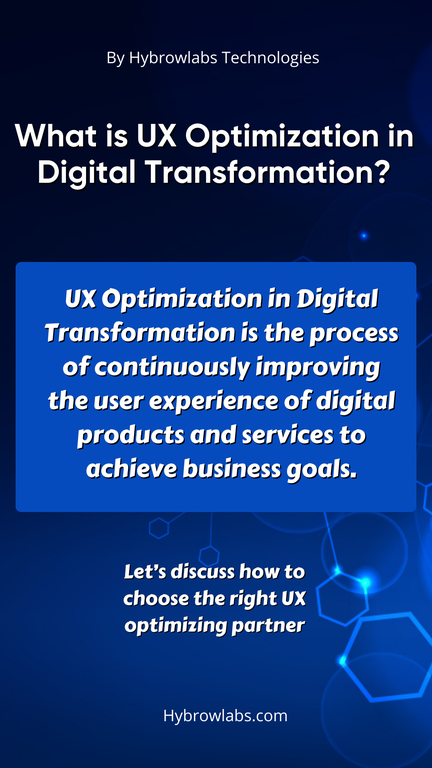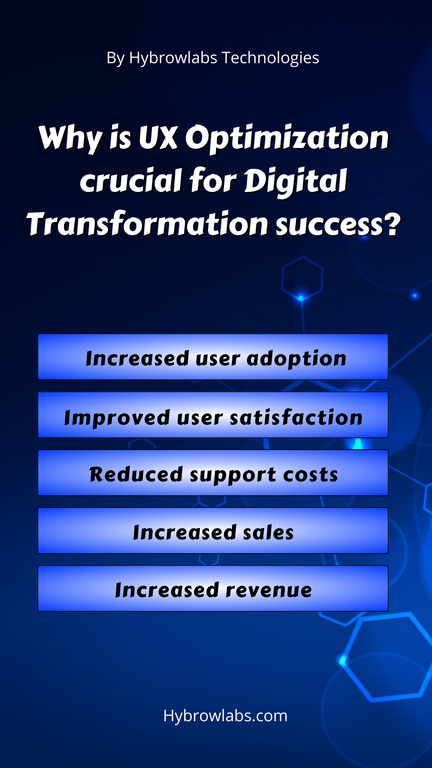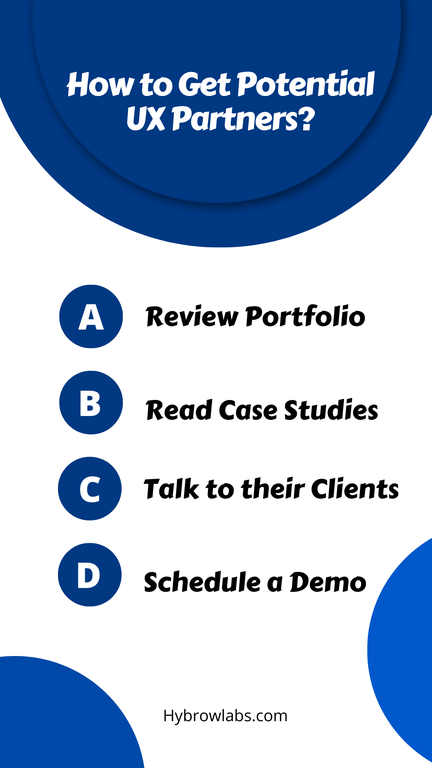Optimizing UX in Digital Transformation: Selecting the Ideal Partner
Dive into the pivotal role of UX optimization in digital transformation and discover the key considerations for selecting an ideal partner to elevate your user experience journey.
In the dynamic landscape of digital experiences, optimizing User Experience (UX) is not just a preference but a necessity. Did you know that 88% of online consumers are less likely to return to a site after a bad experience? As organizations navigate the realms of digital transformation, selecting the right partner emerges as a pivotal decision. Today in this blog we will guide you on how to select the right partner for your UX optimization in digital transformation. So let’s start by knowing

What is UX Optimization in Digital Transformation?
The process of using technology to change an organization's operations is known as digital transformation. It can entail a variety of adjustments like rearranging personnel workflows or installing new software and systems.
Enhancing the user experience is one of the key components of digital transformation (UX). Users will find it easy to interact with your digital goods & services if you have a well-designed user experience. This is crucial for success in the digital sphere, as customers have plenty of options & can quickly go to an opponent if they're dissatisfied with your service.
UX optimization is especially important for digital transformation projects. This is because digital transformation often involves introducing new technologies & ways of working. If the UX is not well-designed, users may find it difficult to learn & use the new systems. This can lead to frustration & decreased adoption.
Why is UX Optimization crucial for Digital Transformation success?

A good UX design can lead to several benefits for digital transformation projects, including:
1. Increased user adoption:
A good UX design makes it easy for users to learn & use new systems. This leads to increased user adoption, which is essential for the success of digital transformation projects.
2. Improved user satisfaction:
A good UX design leads to a more positive user experience. This can lead to increased user satisfaction, which can boost morale & productivity.
3. Reduced support costs:
A good UX design can reduce the need for user support. This can save money & improve the overall efficiency of the organization.
4. Increased sales and revenue:
A good UX design can lead to increased sales and revenue. This is because users are more likely to use & recommend products & services that have a good UX.
Key Criteria for Selecting a UX Partner in Digital Transformation:
1. Understanding of your specific needs and goals:
The UX partner should have a deep understanding of your specific needs & goals for the digital transformation project. This will help them to design a UX that is tailored to your specific requirements.
2. Experience with your industry:
The UX partner should have experience working in your industry. This will help them to comprehend your users' requirements & priorities.
3. Ability to work with a variety of technologies:
The UX partner should be able to work with a variety of technologies, including those that you are working for your digital transformation project.
4. Flexibility and adaptability:
The UX partner should be flexible & adaptable. This is important because digital transformation projects can often change direction quickly.
5. Commitment to communication and collaboration:
The UX partner should be committed to communication & collaboration. This is essential for ensuring that the UX design meets your specific needs & goals.
How Can the Right UX Partner Help You Optimize Your UX in Digital Transformation?
The right UX partner can play a vital role in optimizing your UX during digital transformation by offering expertise, direction & support throughout the whole process. Here are some distinctive methods a UX partner can help you to reach your UX goals:
1. User Research and Insight:
A UX partner can conduct in-depth user research to understand your target audience's needs, behaviors, & pain points. This deep understanding of users will inform the design decisions & ensure that the digital transformation initiatives are aligned with user expectations.
2. User-Centered Design:
A UX partner will support a user-centered design process, ensuring that the user's requirements are at the forefront of every design decision. This involves creating user personas, developing user journey maps & conducting usability testing to refine designs & identify usability issues.
3. Design Expertise and Guidance:
A UX partner can provide expertise in different aspects of UX design, including interaction design, visual design & information architecture. They can assist you in creating instinctive, user-friendly interfaces that are visually attractive & easy to navigate.
4. Iterative Design and Continuous Improvement:
A UX partner will promote an iterative design process, where designs are continuously tested & refined based on user feedback. This ensures that the final product is optimized for usability & user satisfaction.
5. Cross-Functional Collaboration:
A UX partner can facilitate cross-functional collaboration between different teams involved in the digital transformation project, like product managers, developers & marketing teams. This ensures that UX is considered throughout the entire development lifecycle.
6. UX Strategy and Governance:
A UX partner can help you develop a comprehensive UX strategy that aligns with your overall business goals. They can also establish UX governance frameworks & processes to ensure that UX is consistently prioritized & integrated into your organization's culture.
How to Optimize UX in Digital Transformation?
Optimizing UX (User Experience) in the context of digital transformation is crucial for ensuring a successful & seamless transition. Here are some strategies to optimize UX during digital transformation:

1. Emphasize User-Centric Design:
- Understand User Needs and Pain Points: Conduct thorough user research to understand your target audience's needs, behaviors, motivations & pain points. This includes surveys, interviews, user observation & competitor analysis.
- Create User Personas: Develop detailed user personas that represent the different types of users who will interact with your digital products or services. These personas should include demographic information, goals, behaviors & pain points.
- Map User Journeys: Create user journey maps that visualize the steps users take to accomplish specific tasks within your digital products or services. Identify potential friction points & opportunities for improvement.
2. Adopt an Iterative Design Process:
- Start with Wireframes and Prototypes: Create low-fidelity wireframes & interactive prototypes to visualize & test your design concepts early on. Gather feedback from users & stakeholders to refine your designs.
- Conduct Usability Testing: Perform usability testing with real users to identify usability issues & areas for improvement. Observe how users interact with your designs & gather their feedback to make necessary changes.
- Continuously Iterate and Improve: Design is an iterative process. Continuously test, refine & improve your designs based on user feedback & data-driven insights.
3. Prioritize Accessibility and Inclusive Design:
- Follow Accessibility Guidelines: Stick to established selected guidelines, like WCAG 2.1, to ensure that your digital products or services are useful to people with disabilities.
- Incorporate Inclusive Design Principles: Use inclusive design principles to create products that are usable by various range of users, regardless of their capabilities or limitations.
- Conduct Accessibility Testing: Perform accessibility testing to identify & address barriers that may prevent certain users from fully accessing & using your digital products or services.
4. Measure and Evaluate UX Success:
- Establish UX Metrics: Define key UX metrics that align with your business goals, like user satisfaction, task completion rates, and conversion rates.
- Track UX Performance: Regularly collect data on your UX metrics to track performance & identify areas for improvement.
- Analyze User Feedback: Gather feedback from users through surveys, interviews & feedback forms to understand their experiences & identify areas for improvement.
5. Incorporate Emerging Technologies and Innovation:
- Stay Updated on UX Trends: Keep abreast of emerging UX trends, technologies & design patterns to stay ahead of the curve.
- Experiment with New Technologies: Explore & experiment with new technologies like voice interfaces, augmented reality & virtual reality, to enhance user experiences.
- Balance Innovation with Usability: Make sure that the invention does not come at the cost of usability. Prioritize user needs & ensure that new technologies are executed in a way that enhances, rather than detracts, from the user experience.
6. Foster a User-Centric Culture:
- Integrate UX into the Organization: Advocate for UX to be considered throughout the entire digital transformation process, from planning & development to deployment & maintenance.
- Educate and Empower Teams: Provide UX training and workshops to educate your team about the importance of UX & how to incorporate user-centered design principles into their work.
- Encourage User Feedback: Create channels for users to provide feedback & ensure their feedback is heard & acted upon.
7. Seek Expertise and Guidance:
- Collaborate with UX Professionals: Consider partnering with UX experts to gain access to specialized knowledge, skills & resources.
- Learn from Industry Leaders: Attend UX conferences, workshops & webinars to stay updated on the most promising practices & learn from industry experts.
- Engage with UX Communities: Participate in online & offline UX communities to share knowledge, exchange ideas & learn from others.
How to Get Potential UX Partners?

1. Review Portfolio:
Take a close look at the potential partners' portfolios to examine examples of their past work. This will give you insights into their UX design skills & the quality of their output.
2. Read Case Studies:
Dive into their case studies to better understand their approach to UX design. Case studies provide valuable information about their methodology, problem-solving capabilities & the actual results they've achieved in past projects.
3. Talk to their Clients:
Reach out to the clients the UX partner has worked with previously. By gathering feedback from these clients, you can see the partner's strengths, weaknesses & overall performance firsthand. This step is crucial for making an informed decision.
4. Schedule a Demo:
Take the opportunity to see the UX partner in action by scheduling a demo of their UX design process. This firsthand experience will allow you to witness how they work, their collaboration style, and the tools & methodologies they employ. It's a practical way to assess if their approach aligns with your needs & preferences.
Digital Transformation: How to Measure and Improve UX Over Time?
Measuring and improving User Experience (UX) over time involves a combination of quantitative & qualitative methods. Here's a comprehensive guide to help you in this iterative process:
Measuring UX:
1. User Analytics:
Utilize tools like Google Analytics to track user behavior, including page views, time spent on site & user journeys. Analyzing this data provides insights into user preferences & areas for improvement.
2. Surveys and Feedback:
Implement user surveys & feedback forms to gather direct insights from your audience. Pose questions about usability, satisfaction & specific features. Pay attention to recurring themes & suggestions.
3. Usability Testing:
Conduct regular usability testing with real users. Observe how users interact with your product, identify pain points & note areas of confusion. Use this feedback to make targeted improvements.
4. Conversion Rates:
Monitor conversion rates for key actions (e.g., sign-ups, and purchases). A positive UX should correlate with higher conversion rates. Analyze any drops or increases to identify UX-related factors.
Conclusion:
In conclusion, the journey of digital transformation is a testament to the ever-evolving landscape of user experiences. The choice of an ideal partner remains pivotal in this endeavor. By embracing user feedback, iterative design & a commitment to excellence, organizations can thrive in the evolving digital realm. May your digital transformation be a seamless & gratifying journey for users & businesses alike. Partner with Hybrowlabs for the best experience in UX Design and Optimization in your digital transformation journey. Our expert developers will do the research and collaborate with you to ensure you the best quality work.
FAQ:
1. How can I measure the success of UX in my digital project?
Success can be measured through various metrics, including user analytics, conversion rates, usability testing & user feedback. These indicators help gauge user satisfaction, engagement & the effectiveness of your digital experience.
2. What role does a UX partner play in digital transformation?
UX partner who brings expertise in user research, design & testing to ensure that the digital transformation aligns with user needs. They contribute to the creation of a seamless & user-centric experience throughout the transformation process.
3. How often should I update my digital assets for an optimal UX?
Regular updates are essential to maintain an optimal UX. The frequency depends on the nature of your digital assets & the pace of technological advancements. Continuous monitoring, user feedback, & industry trends should guide the update schedule.
4. How can I enhance accessibility in my digital solutions?
Improving accessibility involves adhering to standards like WCAG, conducting accessibility audits, and designing interfaces that consider diverse user needs. Regular updates & testing help ensure a more inclusive digital experience.
5. What is A/B testing, and how does it improve UX?
A/B testing involves comparing two versions (A and B) of a design to determine which performs better in terms of user engagement or conversions. It helps identify the most effective design elements, leading to data-driven improvements in UX.
Sangita
Hi, thanks for taking a look at my profile. I'm Sangita, a blogger at Hybrowlabs, a web and mobile development firm. With a passion for storytelling, I create engaging content on technology, marketing, and lifestyle. My versatile writing style blends creativity with professionalism while staying up-to-date with industry trends. I aim to make complex concepts accessible and inspire through my words.
No comments yet. Login to start a new discussion Start a new discussion